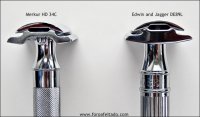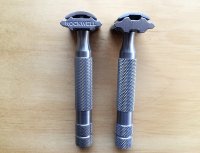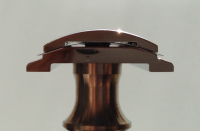Carpentry terns in relation to razor design. We may be treading beyond BOSC here!

. . . that bit of support at the edges and center really make it rigid, in the same way a wide span floor beam is shored up by a jack post. I can visibly flex the center of my EJ DE89 with my fingernail, but I'd need a screwdriver to flex the blade on my RR Teck II and it seems like it's because of those "risers" or "posts".
Maximum deflection when pushing down on a simply supported beam that has a pin on one end and a roller on the other end is proportional to L^3, the length of the beam cubed. The difference between deflection when pushing down on a razor with three risers (ends and middle) versus a razor with two risers (ends only) is roughly governed by a length of L/2 versus L, so the razor with three risers has a deflection that is (1/2)^3 = 1/8 as much as that with the two-riser razor. The razor with no risers, e.g., the EJ DE89, definitely has more deflection, but my simple comparison cannot be used to quantify it.
In my dream of dreams, rather than having a "pass around", we would have "pass-in", and send examples of all sorts of razors into 1 central place where they could be measured according to all these parameters, so that we could finally stop talking subjectively about "aggressive", "efficient", "mild" etc. I'd much prefer to hear about "blade exposure", "blade angle", "guard span", and "clamp distance". I'm a bit of an eccentric though.
I've proposed such a thing going back to last year, shortly after I started DE shaving, with the hopes that I wouldn't be the only one analyzing razors but that I'd inspire some others to get involved as best as they can. Several brothers here have graciously offered to lend me razors for analysis. Unfortunately, I haven't been able to take up their offers yet.
I guess what I'm trying to say is that I think that the single most important parameter in "rigidity" is "clamping distance".
Both the free-end distance and the clamp distance matter. You can have a longer clamp distance but less blade deflection with a shorter free-end distance compared to having a shorter clamp distance that is equal to the free-end distance. Think of pushing the clamp farther away, which would cause more deflection, but then add a one-sided support (not a clamp) close to the cutting edge that signficantly reduces deflection.
The EJ DE89 clamp distance is 5.44 mm and the free-end distance is 1.92 mm for an average 21.96 mm blade width, according to my analysis (URL for my analysis).
I think the absolute minimum "clamp distance" for any razor is when the "free end distance" = "clamping distance". I could be wrong about that too though!...
The last bullet point in my illustration notes how clamp distance is greater than or equal to free-end distance. You are right.

. . . my point is that on open comb razors, and "riser supported razors" like the RR Teck II, the presence of support on the bottom reduces "clamp distance" by definition. That may or not be important for rigidity. I think it might be.
Yes. You're right. Is the blade even clamped between the risers? Are the risers the only clamping areas?
It may well be that the most important thing is "free-end distance". My RR Teck II has the smallest "free-end distance" of any razor I've ever seen at 1mm. I really don't have a clue, but I can't wait for my Fatip Grande to roll in so I can begin to experiment and see what if any effect rigidity is having!
Clamp and free-end distances both matter, but maybe free-end distance dominates more for real razors. I don't know!







 !
!








